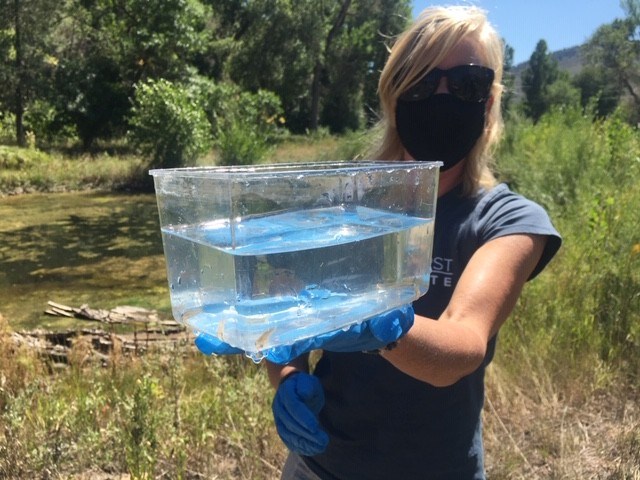A joint conservation effort that has drawn national attention, will culminate Saturday with the release of the Colorado native, endangered northern redbelly dace, into Webster Pond at Pella Crossing. The release — scheduled from 10 a.m. to noon — is a celebration of over two years of work by multiple organizations, including the St. Vrain Valley Schools Future-Ready Innovation Lab.
“I have enjoyed watching these little fish grow up and love using our sensors to learn more about what the dace needs to thrive in their environment,” said Innovation Center sophomore student Taryn McDermid, in a Boulder County news release. Taryn joined the project because it combined her passions for the outdoors and robotics. “This project is really important to me because of how important these fish are to the environment and to our community.”
Saturday’s event will include several hands-on activity stations for children, according to the news release. Members of the public are encouraged to park at Hygiene Elementary School and Westview Middle School. A free shuttle service to Pella Crossing will be provided by St. Vrain Valley Schools’ transportation department.
Boulder County Parks & Open Space, Colorado Parks and Wildlife, or CPW, Denver Zoo, the Innovation Center, Lyons Middle Senior High School, Ocean First Institute and graduate students with University of Colorado-Boulder have all worked in a nationally recognized partnership to implement the reintroduction of the species to the St. Vrain River and educate students about the scientific process and importance of the successful reintroduction of the threatened species, the news release states.
The northern redbelly dace is a state endangered species and extremely rare in wetlands along the Front Range, where it is native to Colorado, said Boyd Wright, Aquatic Conservation biologist for Colorado Parks and Wildlife, in the news release.
“This unique project supports CPW’s goal of replicating populations of the species in suitable habitat within its native range, but perhaps more importantly engages the local community in the conservation of a little known fish species,” Wright said. “It’s a rare and exciting project for a rare fish, and it wouldn’t be possible without this outstanding partnership.”
The Colorado Parks and Wildlife Native Aquatic Restoration Facility in Alamosa provided the fish to start the project. Students at Lyons Middle Senior and the Innovation of St. Vrain Valley Schools raised the fish housed at the Innovation Center, the news release states. The goal of the project is for the dace to be released into Webster Pond ahead of final reintroduction into the St. Vrain River. Post-reintroduction, students will continue to study the success of the project by monitoring the fish by utilizing underwater robotics, applying artificial intelligence and conducting tests on the water quality through various means including eDNA testing, according to the news release.
The initial release to Webster Pond was delayed from its scheduled summer 2020 release because of the COVID-19 pandemic, the news release said. A previous batch of northern redbelly dace was successfully released in a different location in fall 2020. Webster Pond was initially a man-made pond but was significantly altered by the 2013 floods, the news release states. Boulder County Parks & Open Space transitioned the ecosystem to an emerging wetland, an ideal environment for the reintroduction of a rare and endangered fish species, the news release said.
“After beginning this project at the start of the pandemic, we have worked tirelessly to create an environment for these fish to not only survive, but thrive at our school,” said Lyons senior Cassidy Bates, in the news release. “The first lost their environment just like we did in the 2013 flood. We faced COVID obstacles while raising them, but preserved because the conservation of this species matters.”
All participating organizations have provided funding resources to the project, the news release states. Significant contributions include a $30,000 grant from Boulder County Parks and Open Space Foundation, a $5,000 grant from the Laurent Townsend Memorial Wildlife Fund and a $1,000 grant from the Denver Zoo.

.jpg;w=120;h=80;mode=crop)

